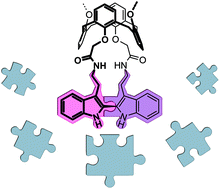Constructing bridged multifunctional calixarenes by intramolecular indole coupling†
Abstract
2,2′-Bisindole units are suggested as new bridging motifs which can be easily created at calixarene cores. In TFA solutions, calix[4]arenes having pairs of indole groups originating from tryptamine or tryptophan residues are converted selectively into macrocycles bridged by indolylindoline moieties. The latter are easily transformed into fluorescent 2,2′-bisindole bridges upon oxidation. The coupling/oxidation sequence works fine at bridging the cavities of the cone and 1,3-alternate (thia)calix[4]arenes in their distal positions. Ester groups, triazole units and crown ether loops, which are practically important functionalities in calixarene chemistry, are compatible with the bridging strategy thus making available diverse calixarene-based hosts comprising novel features provided by the 2,2′-bisindole bridges. Of them the abilities to self-assembly and to bind anions through multiple hydrogen bonds were observed by X-ray crystallography, fluorescence measurements, and NMR experiments. When combined with a cation-binding site, the 2,2′-bisindole units can turn the calixarene molecules into heteroditopic receptors being able to stabilize the anionic parts of the ion pairs. This feature was assessed by using the 1,3-alternate calix[4]arene having the 2,2′-bisindole bridge and the crown-5-ether loop which was found to form neutral complexes with potassium acetate or potassium benzoate.

- This article is part of the themed collection: 2019 Organic Chemistry Frontiers HOT articles


 Please wait while we load your content...
Please wait while we load your content...